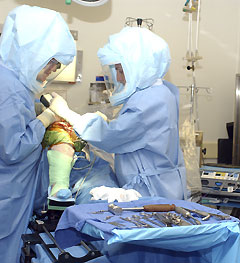For more archives, go to the Advance Archive/Search Page.
New Surgical Device Improves
Precision In Joint Replacement
John Dempsey Hospital has purchased a sophisticated navigation tool to guide its surgeons’ hands during joint replacement surgery.
The tool, called the Aesculap Orthopilot, uses infrared transmitters, laser pointers, cameras, and computers to help the surgeon place the new joint prosthesis in the best spot at the best angle.
 |
|
Surgeons at the Health Center Use a new device that makes joint
replacement more accurate |
“This device tells you within a millimeter where the center of the hip, ankle, and knee are located. It lets you know when the angle of the implant is perfect, not tipped one way or the other,” says Dr. Courtland Lewis, an orthopedic surgeon who was instrumental in getting John Dempsey Hospital to purchase the new tool for his joint replacement program.
Anatomically accurate alignment of the implant is important for the long-term success of joint replacement operations. “Precise implantation of the new joint reduces wear and premature loosening of the joint,” says Lewis.
The device has sensors that are fixed rigidly to the thigh with a pin drilled into the femur. Additional transmitters are fixed to the foot and the calf. When the leg is moved, a camera records the movements of the transmitters and a computer precisely calculates the midpoints of the hip, knee, and ankle joint.
“It’s a non-image based device, which means we don’t need a CT scan or MRI for it to work properly,” says Lewis. “That means we can obtain precise placement information without the added expense of additional X-rays.
“The navigation device provides information that is especially helpful since we have started doing joint replacements with minimally invasive surgery,” he adds. “If we are going to do operations through these little tiny incisions, it makes sense to seek out tools that can provide more information.”
Traditionally, knee replacement surgery was done through an incision measuring about eight inches in length. Minimally invasive knee replacement surgery uses an incision about half that size. “A smaller incision means less disruption to surrounding tissue,” Lewis says. “That’s important since we want to minimize injury to the muscles around the bone we are trying to fix, but it also makes it a little more difficult to see what you are doing.”
The device was developed in the 1990’s by Aesculap, a German company that is the world’s largest manufacturer of surgical instrumentation. It has been used in more than 30,000 total knee replacement operations in Europe, where it was designed and thoroughly tested. The Food and Drug Administration licensed the navigation system for the United States in 2001.
The hospital administration is now obtaining software for the device so it can be used in total hip replacement operations and in repairing anterior cruciate ligaments. Lewis says it should be available by the end of the year.

